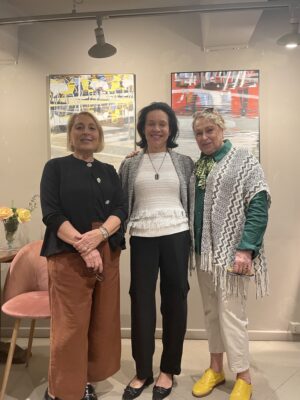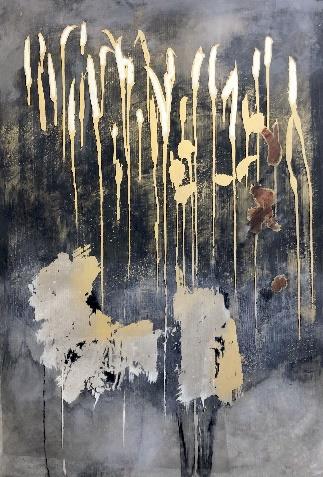 Le opere dell’artista Ursula Radel, che vive e lavora a Vienna, sono rappresentate in permanenza dalla Galleria Mentana di Firenze
Le opere dell’artista Ursula Radel, che vive e lavora a Vienna, sono rappresentate in permanenza dalla Galleria Mentana di Firenze
Ursula studied History of Art at Jagiellonian University in Cracow (diploma in Modern and Contemporary Art), which was followed by different studies (a. o. in Harvard, USA). She has been living in Vienna since long time, travelling extensively – especially to the Far East and to North America.
She started her artistic career around 15 years ago, studying with Chinese artists ShanZuo Zhou and DaHuang Zhou, based in Chicago and widely known as Zhou Brothers and later continued her studies also with Markus Lüpertz (Ger) und Georg Brandner (Aut).
Artist’s Statement
“I’m primarily an abstract painter, although with visible connection especially to landscape painting.
My pictures are painted dynamically, on a grand scale. They emanate a wealth of color and latent emotion. The richness of color does not come from a wide range of colors, but how they are put together. I try to achieve a carefully thought-out and precisely linked construction of planes.
Recently I started a series of figurative paintings, which deal mostly with people and their perception of arts. I’m right now fascinated with the world outside of a museum or an art fair but seen from inside a museum – it is a look out on the street: visitors, who just left or casual bystanders. “
An art critic wrote about her painting:
“The pictures (…) are painted dynamically, on a grand scale. They emanate a wealth of colour and latent emotion. We enter a world of coloured stains, which suggest that space has given birth to something new, something worth recording. The artist constructs a pictorial space based on colour. The richness of colour does not come from a wide range of colours, but from her knowing how to put them together. She achieves a carefully thought-out and precisely linked construction of planes. Each ‘stain’ has its own logic, emotional and constructional.
The paintings do not have formal geometry, but they certainly don’t lack structure, which comes from the twists and turns of the brush strokes. Each touch of the brush, contriving both breadth and synthesis, brings to the whole a character of unusual weight. It has a life of its own, and giving off an individual radiance it goes towards bringing about that overall harmony which can be likened to that of a musical symphony. A diversity of images arises from a palette of warm and cold colours whose rhythm, discreetly but unwaveringly, leads to a play of values. The range of values addresses the intellect; the range of colours expresses the emotions.”
“Ursula Radel-Leszczynski is – for several reasons – a painter rather unusual”
The first studies, completed with a diploma in Art History, was held at the Jagiellonian University in Cracow. With a resource of knowledge about art, greater and deeper than that of the Academy of Fine Arts and the proper “school of Krakow” in Art History, an objective-analytical look at the work (which, in the case of one’s own works, can protect, among other things, against the naïve joy of crossing the non-existent borders) began artistic studies in Austria. Perhaps less formal than full academic studies, but with good artists and educators – and undoubtedly sufficient. The third element, which essentially influenced the shape of Ursula’s painting became a fascination with the art of the Far East, and especially China. In-depth travels proved to be persistent, and a long collaboration with two Chinese artists, known as the Zhou Brothers, has perfected and deepen the grazing of the painter.
From the Chinese painting she took what for the European artist does not necessarily have to be attractive: a modest, disciplined color palette, in a classic edition limited to black and derived from it grays and red. Indeed, in the practice of Ursula’s painting, they turn out to be surprisingly rich and – although with time she introduced more related colors – this triad would suffice (and is often enough) to build intriguing images. From the gray alone, the painter can bring out surprising wealth.
She paints on canvas and technically the paintings are thoroughly European, but there is something that is concerned about the otherness. Therefore, with even greater enthusiasm, a part of the audience (and criticism) is looking for the compounds of this painting with the big trends of European art. And here the paintings begin to put a silent but firm resistance.
There is an interesting light in them, so Impressionism automatically arises. However, it is enough to look at the paintings (especially from the “Grey” series) to see that it is a light other than that received in the heritage after the Impressionists and has a different role. For the Impressionists the Light (along with the color) was an expression of awe towards the beauty of the world and the joy of stopping on the canvas of the moment’s fleeciness. The light in Ursula’ paintings often seems to be reaching from distant galaxies teaming the recognized with the undiagnosed, with seriousness that excludes excess emotions, speaks of eternal continuance; It emphasizes what was before us and what will remain when we will not..
It is even harder to locate the paintings of Ursula Radel-Leszczynski in the abstraction. Painting resulting directly from the widely understood nature, tracing all that happens on the border of water, earth and air can be considered as landscapes (although not necessarily in the traditional sense), but in no case is an abstraction. Even if it uses abbreviations and imports of forms of the world seen in characters, moreover, the most readable. Geometric figures that are placed in images are far from mathematical calculations that are a function of geometric abstraction. Often, however, they become the carriers of symbols, sometimes reaching the archetype, which makes them universal and allows you to read more than local cultures.
It is a very interesting painting, author and independent of the changing fashion and fast-running so-called “dominating trends”. Accompaniment to that is an aesthetic pleasure with elements of intellectual adventure.
Jolanta Antecka, art critic
———————————————————————————————————————-
Upcoming exhibitions:
October 2019 personal show in Florence (Italy) and in Cracow (Poland).
Solo & Group exhibitions:
April 2019 in London in Royal Opera Arcade Gallery (Pall Mall).
May 2018 on The Other Art Fair in Brooklyn (New York).
June 2017 The Other Art Fair in Brooklyn (New York).
“Artist of the Day” on April 7th 2016.
On Saatchi Art (joined Sep 2015):
part of the curated Collections by Rebecca Willson and other curators.
Ursula’s works are in various Collections in Austria, Germany, Poland,UK and USA.
She had regularly single shows in Cracow (e.g. in 2011, 2012, 2015) and in Vienna (e.g. in 2012, 2016) and participated also on regular basis in collective exhibitions in Austria (2004 – 2011) in Germany (2014, 2015), in Italy (e.g. Venice 2016), Monaco (2016)
The artist is represented by the Mentana art gallery in Florence, which follows the path at a professional level. It is advisable to view its personal web page online at www.galleriamentana.it on our shop online e-commerce.



